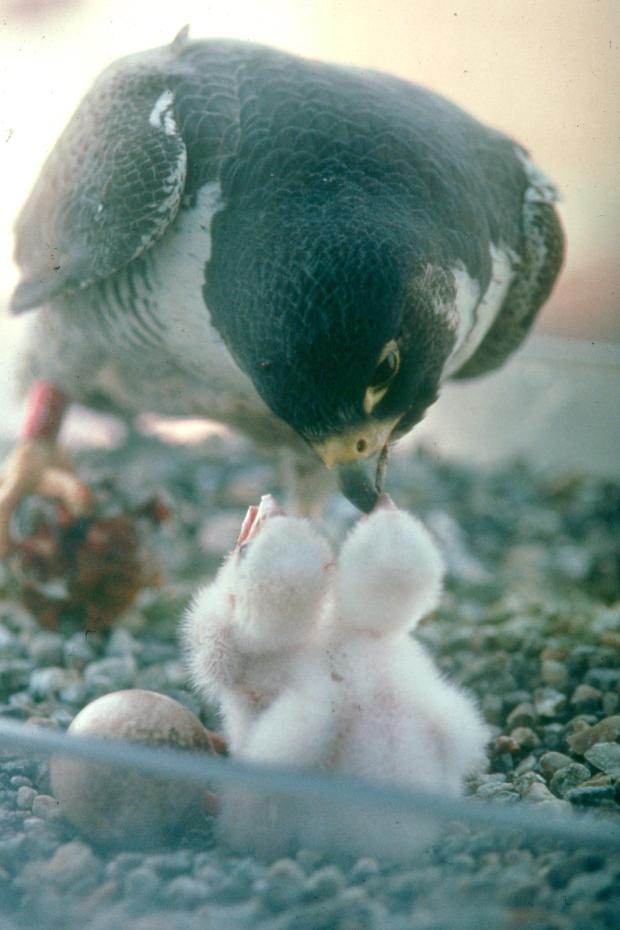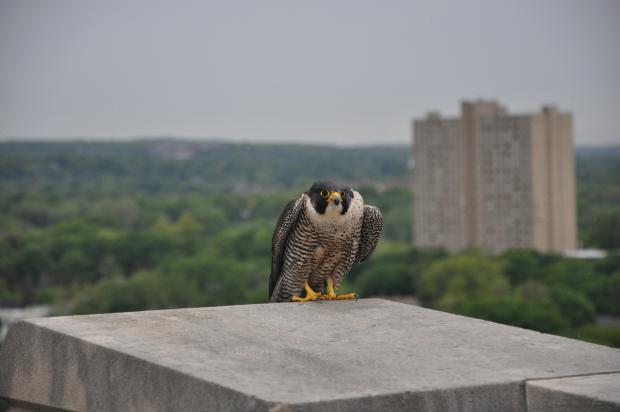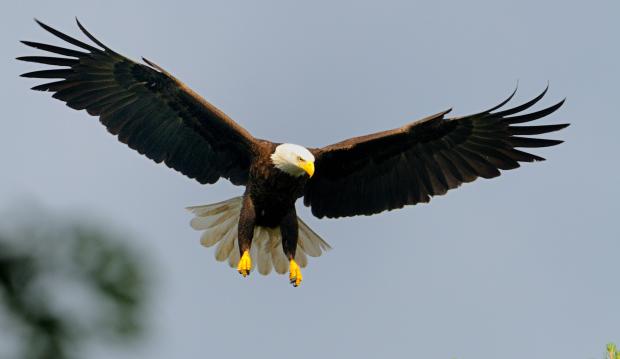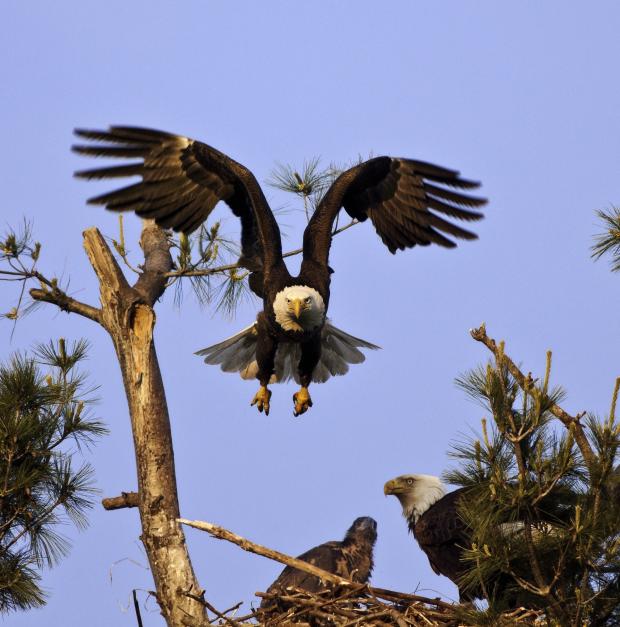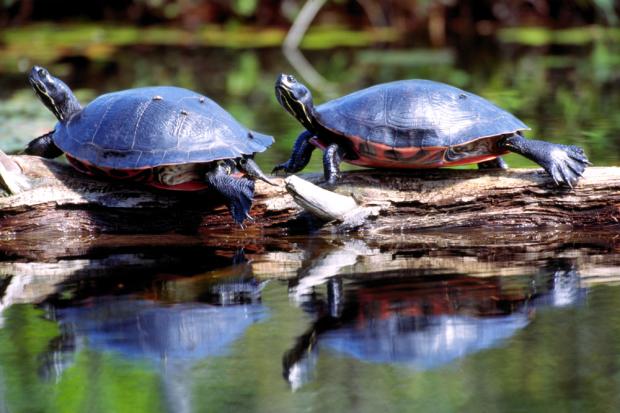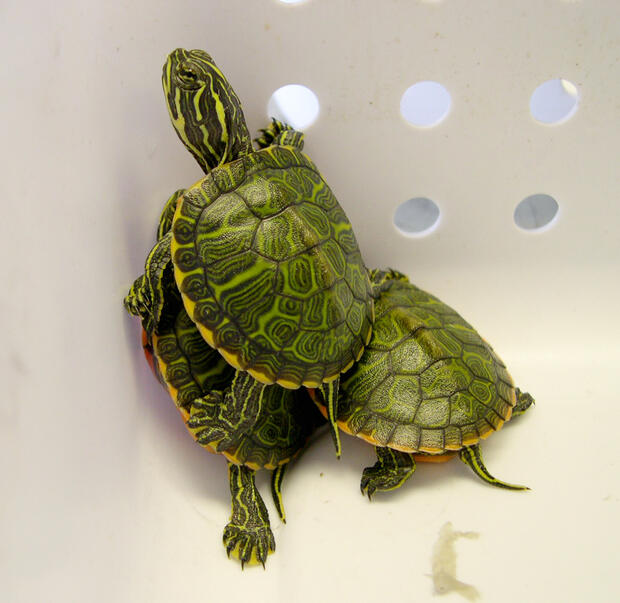Peregrine Falcon
Prior to the use of DDT, a pesticide once commonly used, there were 375 nesting pairs of Peregrine Falcons in the eastern United States. The last nesting pair in Massachusetts was in 1955 on Monument Mountain, and by 1966 there were no remaining nesting pairs in the eastern United States. The Peregrine Falcon was listed as Endangered in 1969 under the Endangered Species Conservation Act. DDT was later banned in 1972.
After being established by the legislature, Peregrine Falcon restoration became the NHESP’s first new project in the early 1980s. The first successful nesting pair in Massachusetts occurred in 1987 on the Customs House Tower in Boston. The Peregrine Falcon was removed from the Federal List of Endangered and Threatened Species in 1999.
Peregrine Falcons now breed annually in Massachusetts and remain in the state year-round. Historically, Peregrine Falcons were restricted to nesting sites on exposed cliffs. With modern construction, Peregrine Falcons in Massachusetts now nest on a wide range of structures, including many buildings and bridge, one cell tower, and quarries. Numerous nest boxes have been installed, nests are actively monitored, and chicks are banded each summer. Banding provides data relating to dispersal, longevity, and recovery from injuries.
In 2025, there were 40 total territorial pairs that nested, of which 20 pairs were successful and fledged at least 55 chicks. Of the 40 territorial pairs, 16 pairs were not monitored closely enough to know their nesting success. An additional 18 nest sites were not visited to determine whether they were active or if chicks fledged. This is the 39th year that Peregrine Falcons have raised young in Massachusetts since their restoration. During these 39 years, at least 1,207 wild-born chicks are known to have fledged.
Peregrine Falcons have shown, and continue to show, a positive upward trend in abundance in Massachusetts and throughout North America. Peregrines are now readily utilizing manmade structures and other human artifacts (e.g. quarries) for nesting. The NHESP recently changed the status of this species from Threatened to Special Concern to reflect the progress that has been made.
Additional Resources
Bald Eagle
The last reported historic Bald Eagle nest in Massachusetts was at Snake Pond in Sandwich in 1905. The Bald Eagle had long been absent from MA as a breeding species before the period of DDT and before this species received protection under the Federal Endangered Species Act. However, migrant and wintering birds continued to be seen, and the Bald Eagle was included on Massachusetts' first regulatory list of endangered species in 1986.
MassWildlife, along with many other conservation partners, began the restoration of Bald Eagles in 1982 after eagles were discovered wintering in the Quabbin Reservoir area. From 1982 through 1988, young eaglets were transported from wild nests, primarily from Canada, to be raised in cages overlooking the reservoir. Once the birds fledged, the cage doors were opened and the birds were free to fly. 41 chicks successfully matured to be released. This process, called hacking, assures that the young birds would view the area as their home base. It is expected that once an eagle grows to maturity (about 5 years old), the eagle would chose Quabbin Reservoir as their nesting territory. This has occurred and, over time, eagles have dispersed to other parts of the state, descending from the original eagles, as well as hacked birds from other northeastern states. The first adult territorial pair resulting from these releases was discovered at Quabbin Reservoir in 1987, the first housekeeping nest was discovered the following year, and in 1989, 2 separate pairs successfully fledged a total of 3 chicks.
From 1990 through 2003, former Massachusetts Environmental Police Officer and master falconer, Tom Ricardi, Sr., raised a total of 24 captive-born Bald Eagles that were released in MA. In the early years, these chicks were fostered into wild nests in MA, and in later years, they were released directly into the wild on the Connecticut River as flying juveniles. Several of these birds, both fostered and directly released, are known to have survived to produce young of their own. Since 2004, Bald Eagles raised by Tom Ricardi have been provided to the Bald Eagle restoration effort in Vermont to be hacked on Lake Champlain.
2025 marked the 37th year that Bald Eagles have raised young in Massachusetts since their restoration. Since 1989, the number of known territorial pairs of Bald Eagles in MA has increased to 98. During these 37 years, at least 1,160 wild-born chicks are known to have fledged, and an additional 8 chicks that were captive-born and fostered have also fledged (1,168 chicks in total).
In 2025, there were 98 total territorial pairs that nested, of which 39 pairs were successful and fledged at least 64 chicks. Another 12 nest sites were not visited to confirm whether the pairs were active. Additionally, 50 pairs were not monitored closely enough to know if chicks fledged.
Additional Resources
- Bald eagle fact sheet
-
Open PDF file, 231.76 KB, Graph of Bald Eagle Pairs and Fledglings 1987-2025 (English, PDF 231.76 KB)
Red-bellied Cooters
The Massachusetts population of the Northern Red-bellied Cooter, formerly the Plymouth Red-bellied Turtle, was federally listed as an endangered species on April 2, 1980. At the time of listing, cooters in Massachusetts were known from only 12 ponds in Plymouth County with an estimated population of fewer than 200 breeding adults. At this time, 60% of the MA population existed in a single pond, which was the site of a commercial cranberry harvesting facility.
A small population size and limited range have made the cooter vulnerable to human activities. Threats from human activities include road mortality and habitat destruction. Nesting habitat is lost either directly by residential lakeshore development or indirectly by fire suppression practices in cooter habitat resulting in forest succession. The decline of available nesting habitat combined with the cooter’s late maturation age (females do not reach sexual maturity until 15-20 years of age), low rate of reproduction, and high rate of hatchling mortality due to intense predation have made it difficult for the Red-bellied Cooter to survive.
To increase the survival of juveniles and their recruitment to the population, MassWildlife began a headstart program for Red-bellied Cooters in 1984. Headstarting is used as a conservation technique to increase recruitment, enhance small populations, restore extirpated populations, and introduce the species to nearby appropriate habitat to expand their distribution. Each year, MassWildlife collects 100-150 hatchlings from the wild. Up to 30 partners raise these hatchlings in captivity for 8-9 months, producing yearlings that at the time of release are approximately the size of a 3-year-old in the wild. The larger yearlings are significantly less likely to be predated and therefore more likely to make it to adulthood.
This is the longest and most intensive freshwater turtle headstart program in existence. Since 1985, 5,103 headstarted turtles have been released at 38 sites in southeastern Massachusetts. Dispersal of headstarted cooters has been confirmed through observations of known headstarted cooters in ponds to which they were not released. The first wild nesting of a headstarted female was documented in 2000. From 2013-2016, MassWildlife and UMass Amherst partnered to study the effectiveness of the headstart program. The study found that annual survivorship rates appear to exceed 95% in many ponds and that reproduction and recruitment in headstarted populations is widespread but locally variable. The headstart program has likely provided a significant contribution to the recovery of the species. It is estimated that the population has increased to 400-600 breeding-age individuals distributed among more than 20 known ponds.
Additional Resources
Contact
Online
Phone
Open M–F, 8 a.m.–4 p.m. (closed noon–12:30 for lunch)
